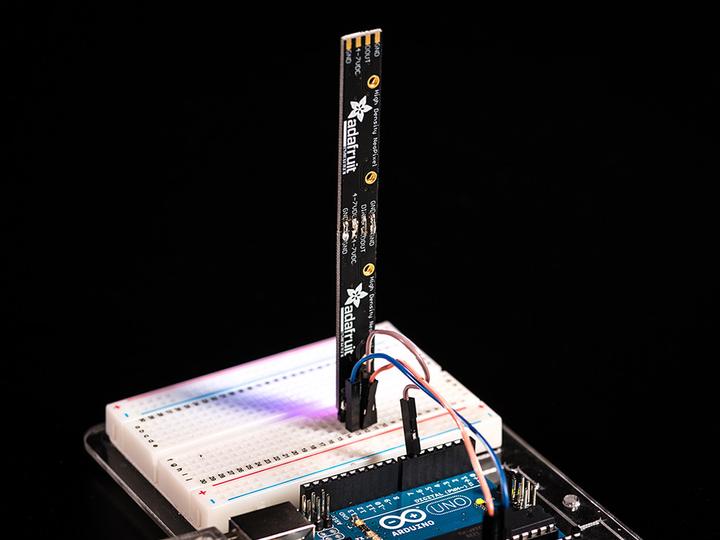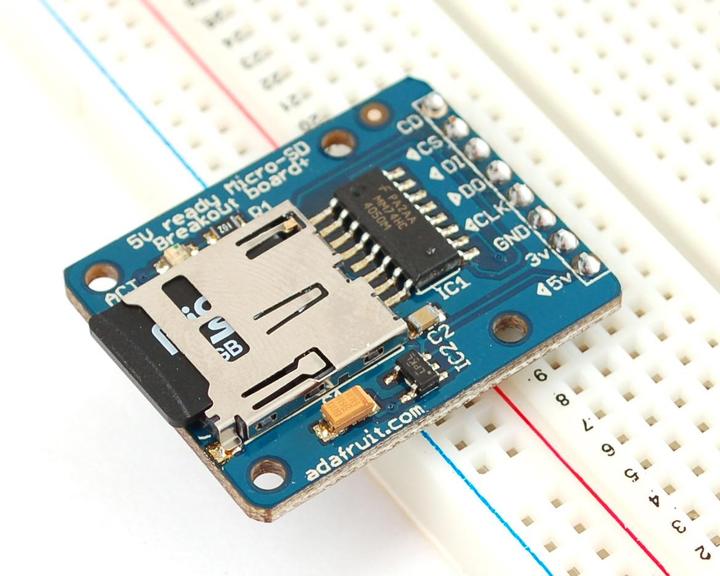
Best Adafruit products in the Electronics modules category
On this page you'll find a ranking of the best Adafruit products in this category. To give you a quick overview, we've already ranked the most important information about the products for you.
1. Adafruit MicroSD card breakout board+
Breakout board with a microSD socket and level shifter for easy connection of the circuit to 5V systems.
- Onboard 5V-3V voltage regulator, 150mA - suitable for power-hungry cards.
- Integrated level shifter makes it suitable for 3V, 3.3V, and 5V projects.
- Activity LED for writing and reading.
- Four mounting holes.
- Push-push socket for easy insertion and removal of the card.
- Comes with header (not soldered) - suitable for breadboards and cables - you decide.
- Ideal for Arduino.
Wiring to the Arduino (for using the SDfatLib):
GND to Ground (yes, really!)
5V to 5V
CLK to Pin 13
DO to Pin 12
DI to Pin 11
CS to Pin 10.

2. Adafruit ADS1115 16-Bit ADC 4 Ch. w/Gain Amplifier
For microcontrollers without an analog-to-digital converter or when
you want a higher-precision ADC, the ADS1115 provides 16-bit precision
at 860 samples/second over I2C. The chip can be configured as 4
single-ended input channels, or two differential channels. As a nice
bonus, it even includes a programmable gain amplifier, up to x16, to
help boost up smaller single/differential signals to the full range.
We like this ADC because it can run from 2V to 5V power/logic, can
measure a large range of signals and its super easy to use. It is a
great general purpose 16 bit converter.
The chip's fairly small so it comes on a breakout board with ferrites
to keep the AVDD and AGND quiet. Interfacing is done via I2C. The
address can be changed to one of four options (see the datasheet table
5) so you can have up to 4 ADS1115's connected on a single 2-wire I2C
bus for 16 single ended inputs.
To get you started, we have example code for both the Raspberry Pi
(in our Adafruit Pi Python library [1]) and Arduino (in our ADS1X15
Arduino library repository [2]) Simply connect GND to ground, VDD to
your logic power supply, and SCL/SDA to your microcontroller's I2C
port and run the example code to start reading data.
* Wide Supply Range: 2.0V to 5.5V
* Low Current consumption: Continuous Mode: Only 150A Single-Shot
Mode: Auto Shut-Down
* Programmable Data Rate: 8SPS to 860SPS
* Internal Low-Drift Voltage Reference
* Internal Oscillator
* Internal PGA
* I2C Interface: Pin-Selectable Addresses
* Four Single-Ended or two differential Inputs
* Programmable Comparator
Links:
------
[1] https://github.com/adafruit/Adafruit-Raspberry-Pi-Python-Code
[2] https://github.com/adafruit/Adafruit_ADS1X15
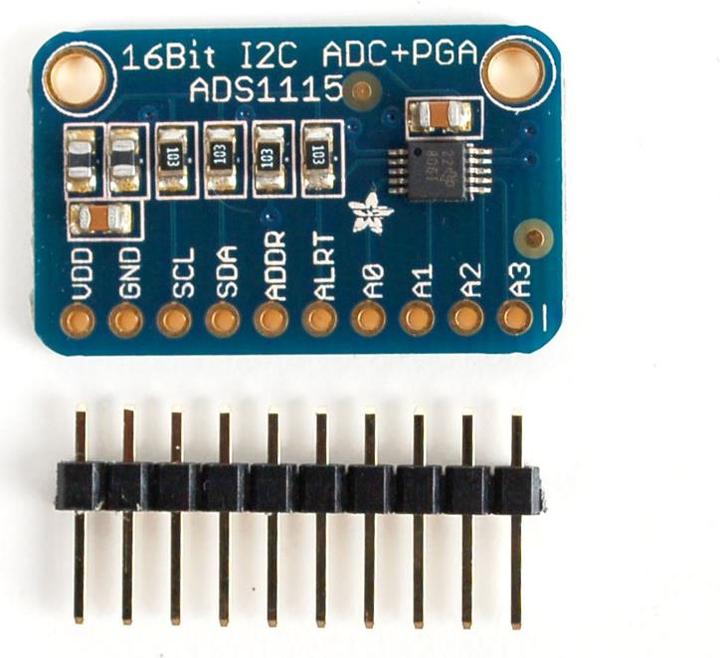
3. Adafruit Magnet sensor
This door sensor is a reed switch made of ABS plastic. Normally, the reed is open (no connection between the two terminals). The other half is a magnet. As soon as the magnet is less than 13 mm away from the switch, the switch closes (connection between the two terminals). These sensors are mostly used to determine whether a door or drawer is open or closed. Therefore, both parts of the sensor have mounting holes, and 4 screws are included in the package.
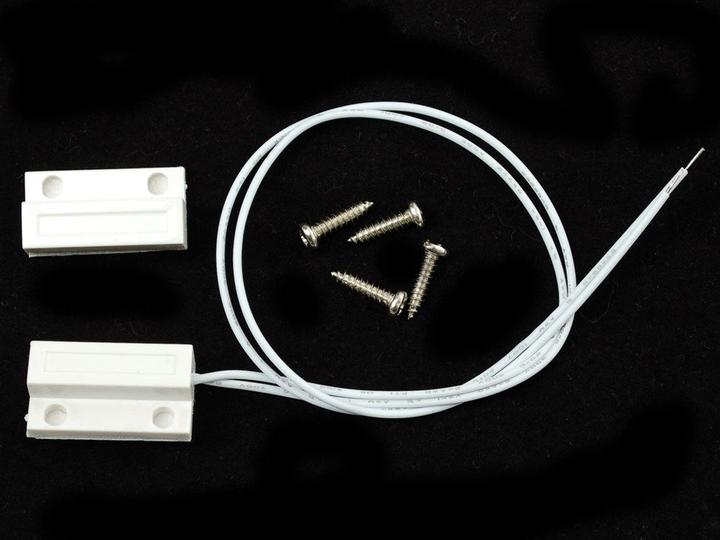
4. Adafruit Mini Metal Speaker
The Mini Metal Speaker from Adafruit is a compact and versatile electronics module, ideal for a variety of audio projects. With a diameter of just 28 mm and a weight of only 6 g, this speaker is particularly space-saving and can be easily integrated into small applications. It offers a resonance frequency of 680 ±20% Hz and a frequency range of approximately 600 to 10 kHz, making it an excellent choice for projects that require clear and precise audio output. The speaker comes with a cable, facilitating installation and connection to various hardware. Its robust construction and ability to operate in a temperature range of -20ºC to 55ºC make it a reliable companion for creative electronics projects.
- Compact design with only 28 mm diameter
- Resonance frequency of 680 ±20% Hz
- Frequency range of ~600-10KHz
- Temperature range of -20ºC to 55ºC.
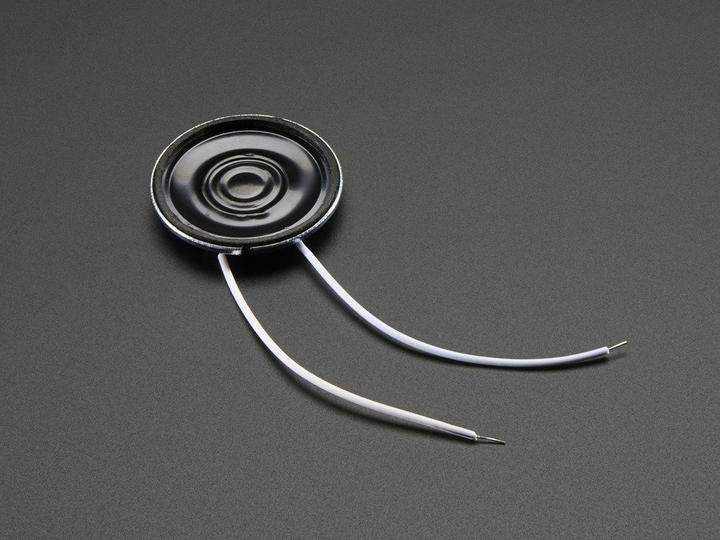
Adafruit Mini Metal Speaker
Loudspeaker
5. Adafruit 2.8" TFT Touch Shield for Arduino v2
The Adafruit 2.8" TFT Touch Shield for Arduino v2 is a versatile electronics module specifically designed for use with Arduino projects. It features a large, bright, and colorful touchscreen display with a diagonal of 2.8 inches and a resolution of 240x320 pixels. The integrated microSD card connection allows for easy data storage and access, while the 4 white LED backlights ensure excellent visibility. The resistive touchscreen design enables the detection of finger touches across the entire screen area, enhancing the interactivity of projects. The shield comes fully assembled and tested, making it ready to use right away. It requires no complicated wiring or soldering, which simplifies integration into existing Arduino setups. With support for SPI communication, it is compatible with various Arduino boards, including UNO, Duemilanove, and Diecimila, and can also be used with Leonardo or Mega by soldering jumpers.
- Resistive touchscreen for precise input
- Integrated microSD card connection for expanded storage options
- Requires fewer pins than the previous model, making it easier to connect additional components
- Quick and easy installation without soldering
- High-quality controller with RAM buffering to relieve the microcontroller.
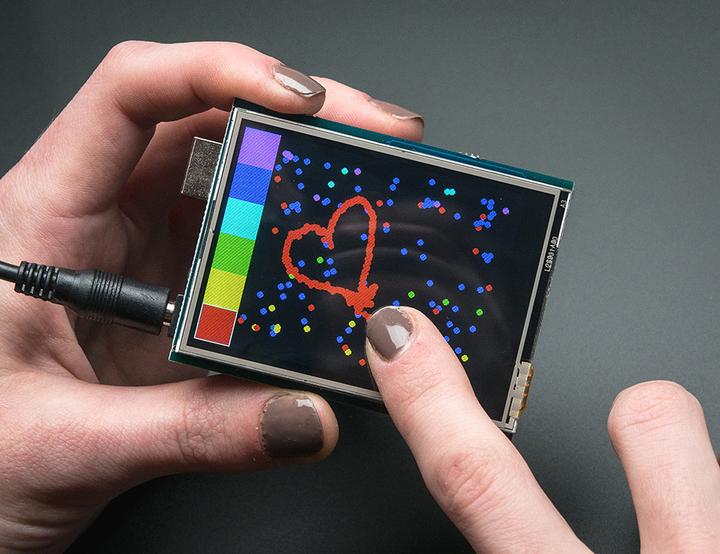
6. Adafruit RGB Matrix HAT RTC for Raspberry Pi
With this HAT for the Raspberry Pi A+/B+, you can easily control all HUB75 RGB LED matrices with 16x32, 32x32, or 32x64 LEDs. You can even cascade multiple matrices; the power of the Raspberry Pi is sufficient to control approximately 32x128 LEDs. A 5V power supply is required to power the LEDs. This is not included in the package along with the LED matrices and the Raspberry Pi and must be ordered separately. The matrix is delivered as a kit. All SMD components are already soldered; only the Pi header, HUB75 connector, and power connector need to be soldered. If you prefer not to do this yourself, we can provide the shield pre-assembled for an additional charge. A CR1220 coin cell battery is required for the RTC (not included). Simple design: just plug it in and run the Python code, protection switch: a 5V power supply can be directly connected to the reverse-polarity protected connector on the HAT, onboard level shifter: converts 3.3V to the required 5V, DS1307 Real Time Clock: so your Pi keeps track of time even when restarted.
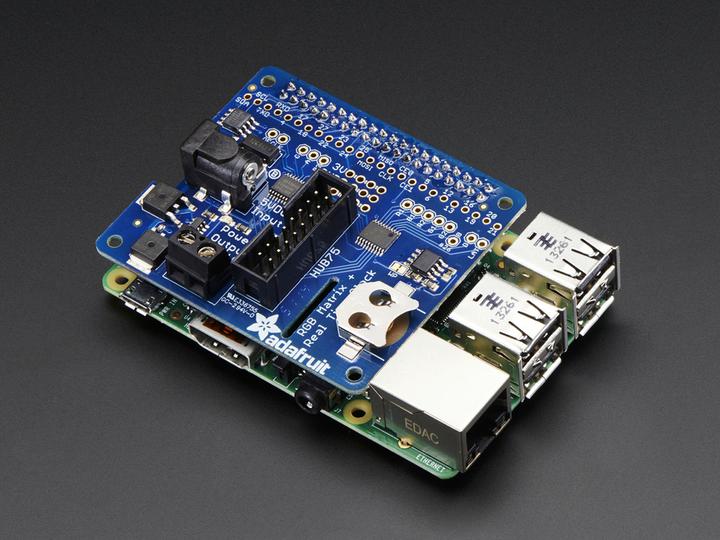
7. Adafruit Pi-EzConnect Terminal Block Breakout HAT
With the Pi-EzConnect you can connect all sorts of electronics to a
single Raspberry Pi with no soldering or breadboarding! This HAT has
screw-terminals for each pin on the Pi Header
Key features:
* Solderless or soldered connections for all GPIO's on a Raspberry
Pi
* Mini proto area for adding components
* Add standard male or female headers for breadboard like
functionality
* Power (both 5V and 3.3V) as well as ground connections available
* Compact footprint - fits easily on top of a Raspberry Pi
* Fully documented pins - easily connect to pin numbers or GPIO
number without referring to external charts
* Protection: Resettable 8V, 1.6A fuse for 3.3V and 5V power
* Header connections: Can use 0.1" (2.54mm) spaced headers, male or
female
* Standoff connections: Matches Raspberry Pi model A+, B+, and Pi 2
Much more information available on the datasheet and on the Alchemy
Power website!
Note: This is compatible with the Raspberry Pi 2 Model B, Model B+,
and Model A+ Not for use with '2x13' Raspberry Pi models such as the
Pi 1 Model B or A.
Links:
* Alchemy Power Website [1]
Links:
------
[1] http://alchemy-power.com/pi-ezconnect/
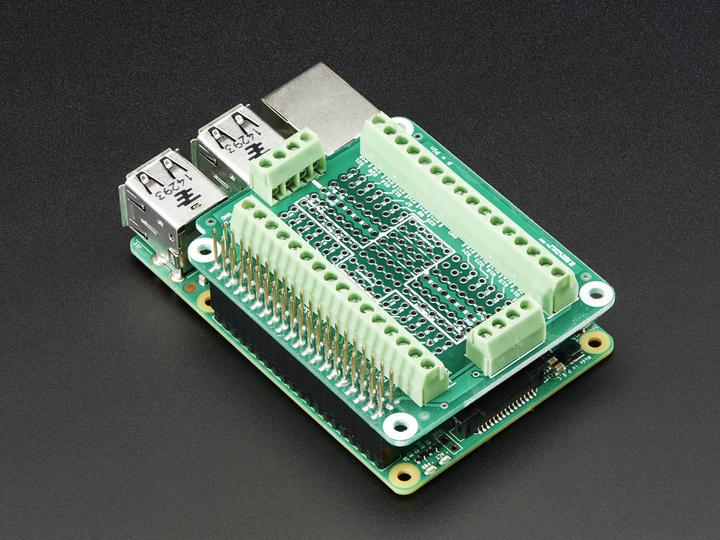
8. Adafruit 3403 Development board ARM Cortex M0+
The Adafruit Feather M0 Express is a versatile development board specifically designed for use with CircuitPython. CircuitPython is a user-friendly variant of MicroPython, making it ideal for beginners in electronics programming. This board is based on the powerful ATSAMD21G18 ARM Cortex M0+ processor, which operates at 48 MHz and supports 3.3V logic. With 256 KB of FLASH memory and 32 KB of RAM, the Feather M0 Express offers significant storage capacity that exceeds that of typical microcontrollers. The built-in USB functionality allows for easy programming and debugging without the need for additional hardware. This board is lightweight and compact, making it an ideal choice for portable projects. It is compatible with both CircuitPython and the Arduino IDE, opening up a wide range of application possibilities.
- Designed for CircuitPython, ideal for beginners in electronics programming
- Powerful ATSAMD21G18 ARM Cortex M0+ processor at 48 MHz
- 256 KB of FLASH memory and 32 KB of RAM for extensive projects
- Integrated USB functionality for easy programming and debugging
- 20 GPIO pins for flexible connection options.
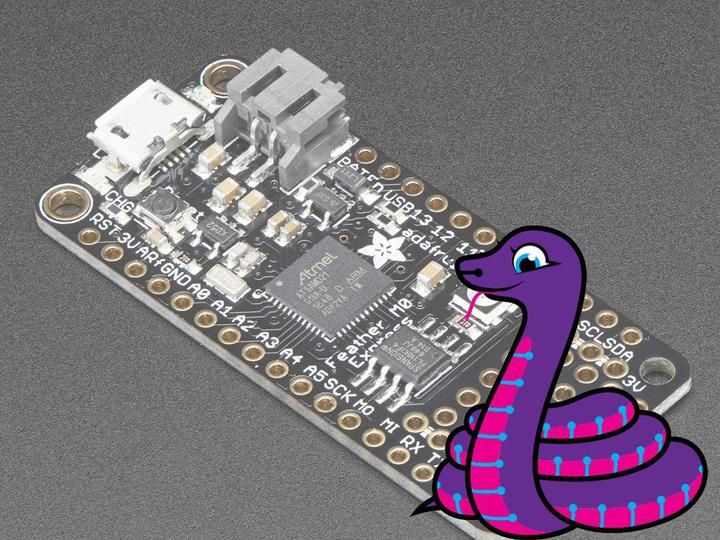
9. Adafruit ADS1015 12-Bit ADC 4 Ch. w/Gain Amplifier
For microcontrollers without an analog-to-digital converter or when you want a higher-precision ADC, the ADS1015 provides 12-bit precision at 3300 samples per second over I2C. The chip can be configured as four single-ended input channels or two differential channels. As a nice bonus, it even includes a programmable gain amplifier, up to x16, to help boost smaller single or differential signals to the full range.
We like this ADC because it can run from 2V to 5V power/logic, can measure a large range of signals, and is super easy to use. It is a great general-purpose 12-bit converter.
The chip is fairly small, so it comes on a breakout board with ferrites to keep the AVDD and AGND quiet. Interfacing is done via I2C. The address can be changed to one of four options, allowing you to connect up to four ADS1015s on a single 2-wire I2C bus for 16 single-ended inputs.
To get you started, we have example code for both the Raspberry Pi and Arduino. Simply connect GND to ground, VDD to your logic power supply, and SCL/SDA to your microcontroller's I2C port, then run the example code to start reading data.
- Wide supply range: 2.0V to 5.5V
- Low current consumption: Continuous mode: Only 150µA; Single-shot mode: Auto shut-down
- Programmable data rate: 128 SPS to 3.3 kSPS
- Internal low-drift voltage reference
- Internal oscillator
- Internal PGA
- I2C interface: Pin-selectable addresses
- Four single-ended or two differential inputs
- Programmable comparator.
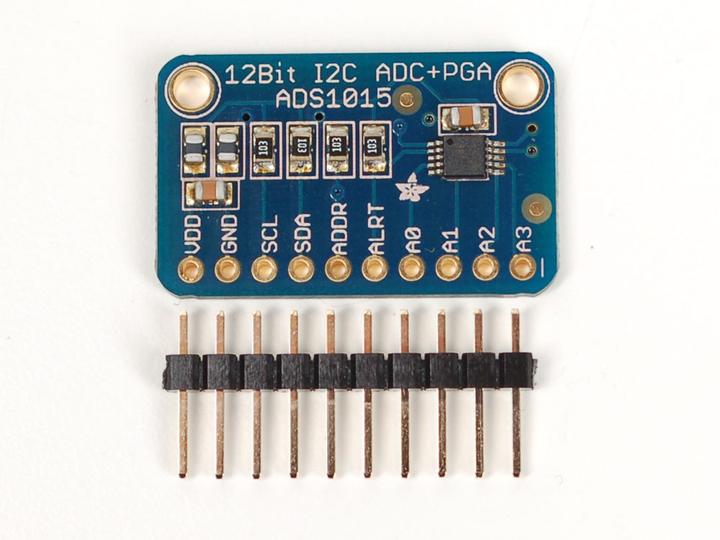
Adafruit ADS1015 12-Bit ADC 4 Ch. w/Gain Amplifier
Add-on
10. Adafruit Neopixel Stick
Use only one microcontroller pin to control as many LEDs as you can chain together! Each LED is addressable, as the driver chip is located within the LED. Each LED has a constant current drive of about 18 mA, ensuring that the color remains very consistent even when the voltage varies. No external current-limiting resistors are needed, making the design sleek. Power the whole setup with 5 VDC (4-7 V works) and you are ready to rock.
